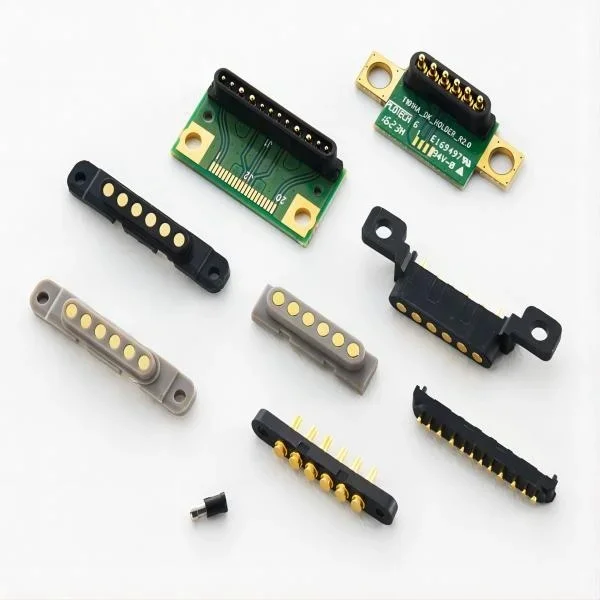In the world of electronic design and manufacturing, connectivity is crucial. Whether you are developing mobile devices, medical equipment, or automotive components, the choice of connectors can significantly influence performance and reliability. One of the most versatile and widely used connectors in modern electronics is the POGO pin. This guide will delve into what POGO pins are, their various applications, and how to choose the right one for your specific needs, with insights from Ganlong-Flying Industrial, a trusted provider of high-quality POGO pins and other connectors.

What is a POGO Pin?
A POGO pin, often referred to as a spring pin, is a precision connector that consists of a spring-loaded probe designed to make temporary connections in electronic devices. The basic construction of a POGO pin includes three components: a needle shaft, a spring, and a needle tube. When compressed, the spring allows the needle shaft to extend or retract, providing a reliable electrical connection.
Key Features of POGO Pins:
- Spring-Loaded Mechanism: This design allows for flexible connections that can accommodate slight misalignments between mating surfaces.
- Gold Plating: Many POGO pins are coated with gold to enhance their electrical performance and corrosion resistance.
- Variety of Structures: POGO pins come in various shapes and sizes, including flat-bottomed, bent, double needle shafts, and threaded options.
Applications of POGO Pins
POGO pins are used in numerous applications across different industries due to their reliability and versatility:
1. Consumer Electronics: Commonly found in mobile phones and tablets for charging and data transfer.
2. Medical Devices: Used in diagnostic equipment and wearable health monitors for secure connections.
3. Automotive: Employed in vehicle sensors and control systems to ensure reliable communication.
4. Aerospace: Utilized in avionics systems where durability and performance are critical.
5. Industrial Equipment: Used in automation systems for connecting sensors and actuators.
How to Choose the Right POGO Pin
Selecting the right POGO pin for your application involves several considerations. Here’s a comprehensive guide to help you make an informed decision:
1. Determine Electrical Requirements
Start by assessing the electrical specifications needed for your application:
- Current Rating: Consider how much current the POGO pin needs to carry. Standard POGO pins typically handle currents between 0.5A to 3A, while high-current options can manage up to 60A.
- Voltage Rating: Ensure that the voltage rating of the POGO pin meets or exceeds your application requirements.
2. Consider Mechanical Specifications
Mechanical properties play a crucial role in the performance of POGO pins:
- Travel Range: This refers to the compression stroke of the spring. Ensure that it aligns with your design's requirements for mating surfaces.
- Contact Retention Force: Evaluate how securely the pin will hold its position when engaged.
3. Choose the Right Plating
The surface finish of a POGO pin can significantly affect its performance:
- Gold Plating: Offers excellent conductivity and corrosion resistance, making it ideal for high-performance applications.
- Nickel Plating: A more cost-effective option suitable for less demanding environments.
4. Select Appropriate Structure Type
POGO pins come in various structural designs:
- External Structures: Options include flat-bottomed, plug-in, bent, or threaded designs depending on your assembly needs.
- Internal Structures: Consider designs like reverse drilling or inclined planes based on your specific application requirements.
5. Evaluate Environmental Conditions
Consider where your device will be used:
- Temperature Range: Ensure that the chosen POGO pin can operate effectively within the temperature limits of your environment.
- Moisture and Dust Resistance: If your application is exposed to harsh conditions, look for POGO pins designed with protective features.
6. Testing and Quality Assurance
Before finalizing your choice, ensure that the manufacturer conducts rigorous testing on their products:
- Mechanical performance testing
- Environmental performance testing (e.g., humidity tests)
- Electrical performance testing (e.g., insulation resistance)
Why Choose Ganlong-Flying Industrial?
At Ganlong-Flying Industrial, we pride ourselves on our extensive experience in manufacturing high-quality connectors, including POGO pins. Our commitment to excellence ensures that our products meet stringent industry standards while providing reliable performance across various applications.
Benefits of Partnering with Ganlong-Flying Industrial:
- Customization Options: We offer tailored solutions to meet your specific design requirements.
- Responsive Customer Service: Our sales and customer service teams excel in handling both bulk and custom orders efficiently.
- Quality Assurance: All our products undergo thorough testing to ensure they meet high-quality standards.
Conclusion
Choosing the right POGO pin is essential for ensuring reliable connectivity in electronic devices. By considering factors such as electrical requirements, mechanical specifications, plating options, environmental conditions, and rigorous testing standards, you can select a connector that meets your needs effectively.
At Ganlong-Flying Industrial, we are dedicated to providing top-notch POGO pins that enhance your product's performance and reliability. If you have any questions or need assistance with selecting the right connector for your project, don’t hesitate to reach out! Together, we can create innovative solutions that drive success in your electronic applications
